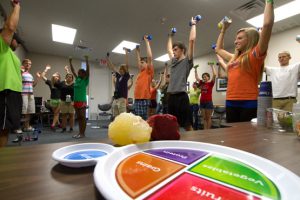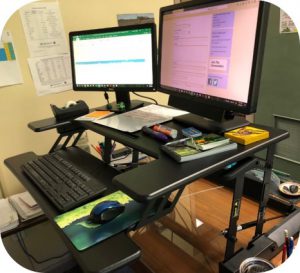
by Melanie Taylor | Mar 11, 2020
This month brings awareness and education about the importance of our kidneys in maintaining a healthy life. Kidney function is unique because you may not notice the symptoms until the function is already far gone. The CDC reports chronic kidney disease is a condition that 1 in every 7 adults (age 18 or older) in the United States has, as well as people with end stage renal disease who need dialysis or a kidney transplant.
How do your kidneys keep you healthy?
- Help remove excess fluid levels in the body.
- Make vitamins that control growth.
- Activate Vitamin D for healthy bones.
- Filter wastes from the blood.
- Control the production of red blood cells.
- Release hormones that help regulate blood pressure.
- Help regulate blood pressure, red blood cells, and the amount of certain nutrients in the body, such as calcium and potassium.
There are many complications associated with kidney disease. They include cardiovascular disease, nerve damage, heart attack, weak bones, high blood pressure, stroke, anemia/low red blood cell count and of course kidney failure.

Speak openly with your doctor about any concerns you may have regarding your health. (Photo source: Tyler Jones, UF/IFAS)
The main risk factors for kidney disease and the problems associated with it are high blood pressure, diabetes, family history, and being 60 years old and above. Out of these four problems, two of them – high blood pressure and diabetes – may be managed by maintaining a healthy lifestyle, taking medications as prescribed, regular visits to your doctor and exercise. If you have been diagnosed with either of these two, you need to regularly monitor your blood pressure and glucose levels, take medications if prescribed, and speak openly with your doctor about concerns or questions you may have. Family history and being over the age of 60 are not issues you can control, but you can strive to live a healthy lifestyle and regularly have blood work drawn so your doctor can help catch any issues that are becoming a problem. Learning to maintain and follow your doctor’s orders will go a long way to keeping you and your kidneys healthy longer.
What are the symptoms you may notice if you are experiencing kidney problems?
- Swelling in your face, hands, abdomen, ankles, and feet.
- Blood in your urine or foamy urine.
- Puffy eyes.
- Difficult, painful urination.
- Increased thirst.
- Fatigue.
If you notice any of these problems or are just concerned because of family history, your family doctor can order the blood work to check your kidney function. If you find out you are experiencing kidney problems you should see a nephrologist – a kidney specialist.
Although many people ignore the importance of their kidneys, they play a very important part in our daily bodily functions in regulating minerals, fluids, blood pressure, and so much more. Striving to maintain a healthy lifestyle will help to ensure your kidneys keep working hard for you. Be sure to show your kidneys some love this March to celebrate National Kidney Month.
Sources:
National Kidney Foundation – https://www.kidney.org/
Center for Disease and Prevention – https://www.cdc.gov/

by Dorothy C. Lee | Feb 3, 2020
February is National Heart Health Awareness Month. On February 7th join the nation and wear red to show support and awareness for women and heart disease.
National Heart Awareness Month is sponsored by the American Heart Association. It is designed to provide the public with information that could lead to a more healthful lifestyle and reduce heart disease.

Go Red for Women’s Heart Health
Photo Source: Dorothy Lee
The Centers for Disease Control and Prevention estimates that 610,000 people die of heart disease in the United States yearly. According to the American Heart Association heart disease and stroke kills one in three women yearly in the United States. Heart disease is a silent killer. It often strikes without warning.
Know the risk factors and symptoms of heart disease. Risk factors are family history of heart disease, diabetes, poor diet, high blood pressure and cholesterol levels, excessive alcohol use, smoking and physical inactivity.
The diet choices we make today are important to our nutritional well-being tomorrow. A diet low in saturated fat and cholesterol, high in fruits and vegetables, and grain products that contain some type of dietary fiber may reduce the risk of heart disease.
Our health is our most precious possession. A healthy diet is only one part of a heart healthy lifestyle. Physical activity is another important component. The American Heart Association physical activity guidelines recommend some type of aerobic exercise daily. Walking, dancing, biking, swimming, or gardening are good examples. Be sure to consult your physician before starting any exercise program.
We are all concerned about maintaining good health. Take steps to a healthier heart. Develop good eating habits based on moderation and variety, plus physical activity can help keep and even improve your health. So, reach in the back of the closet and find that little red dress and wear it this year on Friday, February 7th in support of Women’s Heart Healthy Awareness. Go Red!
Resource: www.heart.org
For further information, contact:
Dorothy C. Lee, C.F.C.S.
UF/IFAS Extension Escambia County
3740 Stefani Road
Cantonment, FL 32533-7792
(850) 475-5230
dclee@ufl.edu

by Dorothy C. Lee | Jul 21, 2019
Eating healthy is not something that just happens by going on a particular diet. In fact, the best kind of diet is where the right choices are made, and it becomes a way of life. Sometimes we need to know some ways to change the bad habits we have developed. There is no ‘quick fix’.

Tune Up Your Lifestyle
Photo Source: UF/IFAS
With today’s fast-paced lifestyles sometimes we feel we don’t have the time to do the things we know we should. For instance, to get more exercise, do things like park a distance from the store when you go shopping, walk up and down the stairs instead of taking the elevator, walk to lunch, or even turn up the speed on regular activities you perform around the house.
When grocery shopping choose foods from the basic food groups (fruits, vegetables, whole grains, lean protein, and reduced-fat dairy products) to round out a healthy meal plan.
Convenience foods are a part of today’s lifestyle, but they often lack nutritional quality, texture, and flavor. Preparing foods at home can be healthy and economical. You can boost nutrition and flavor by adding fresh herbs, spices, and aromatic vegetables to the meal menu.
Foods and beverages high in sugar add empty calories to the diet and contribute no nutritional value. Read labels to determine the amount of added sugar in food products. Choose lower calorie beverages.
Experiment with new food items. Try adding different fruits, vegetables, or grains to your diet. For example, try tropical fruits such as mango, guava, papaya, or grains as quinoa, barley, or millet, to add vitamins, minerals and fiber to the diet.
Before you go out to eat, don’t starve yourself. Drink water before the meal to avoid overeating or eat a snack before dinner and you won’t be tempted to overeat.
When socializing don’t meet at eating places. When you do dine out, cut out fried main dishes or ones with heavy sauces and gravies. Eat smaller portions and don’t go back for seconds. Order low-fat foods when possible. However, keep in mind that you too need to allow for indulgence along the way.
Be active! Physical activity has health benefits. Being physically active not only burns calories, it aids in physical strength, and cardiovascular health. U.S. Dietary Guidelines recommend being physically active at least 150 minutes a week for adults. (https://health.gov/dietaryguidelines/).
Chances are, along with a healthy diet and regular physical activity, your tune up will result in living a healthy lifestyle.
https://www.freshfromflorida.com/Consumer-Resources/Buy-Fresh-From-Florida/Tropical-Fruit
https://www.tropicalfruitgrowers.com/
For further information, contact:
Dorothy C. Lee, C.F.C.S.
UF/IFAS Extension Escambia County
3740 Stefani Road
Cantonment, FL 32533-7792
(850) 475-5230
dclee@ufl.edu

by Angela Hinkle | May 6, 2019
Spring has sprung! Have you? One way to shake off those groggy winter hibernation feelings is to Put a Little Step In Your Spring.
Regular Brisk Walking
- Means you can talk but maybe not sing. You may be slightly out of breath.
- Improves overall health.
- Can help you maintain a healthy weight.
- Prevents chronic health conditions including heart disease, high blood pressure, and type 2 diabetes.
- Strengthens bones.
- “Boosts” or increases muscle power and endurance.

Ready to walk to the top (of Mt Vesuvius) Photo Source: Richard Waid
Strive for 10,000 Steps a Day
- Spring clean your house.
- Mow the lawn.
- Dance around your living room.
- Take the stairs.
- Park in the farthest spot in the parking lot from your destination.
- Wear a pedometer or electronic fitness device to measure how many steps you’ve gone.
- Try for at least 30 minutes a day. If you can’t – break up your walking into smaller segments.
- Vary your intensity – speed up, slow down. Then repeat.
- Vary the view. Try different settings to walk – your neighborhood, the beach, or the woods.
Make It Social
- Let your dog take you for a walk. (Be sure to bring cleanup bags with you and have your best friend(s) on a leash.)
- Walk with friends.
- Make it a family routine.
- Join a walking club.
- Compete with a group to see who can get the most steps.
- Walk in the mall or a park. And say hello to people as you pass by.
- Mindful walk – notice the colors around you, how your feet feel as they step down on different surfaces, the variety of sounds you hear on your walk. Meet someone along the way. Learn their name…and remember it. For info on mindfulness, check out this UF/IFAS publication: Mindfulness: An Introduction.
Always remember to walk in a safe environment, wear comfortable walking shoes, and check with your medical provider for the best walking strategies for you.
So this spring, see how the flowers pop in color. Hear all the different sounds the birds make or enjoy some of your favorite music. Feel the wind and sun on your face. You can do all that and more when you Put a Little Step in Your Spring.

by Angela Hinkle | Feb 8, 2019
Do you know what the different types of cholesterol are in your body? Do you know what your cholesterol levels are? Do you know why your numbers matter? Cholesterol can be a contributing factor to heart disease. It’s important to understand your numbers so you can take the best care of yourself. Making simple changes in your daily routine can help reduce your risk of heart disease. Talking to your doctor is the first step so he or she can request blood tests to help determine your risk. One of the tests the doctor may run is called a lipid profile, which checks your body’s cholesterol.
What should my cholesterol numbers be?
- Total cholesterol should be somewhere between 125 to 200 mg/dL
- LDL cholesterol is called “bad” because it can block your arteries. The level should be less than 100 mg/dL. If it starts with “L”, aim for a lower number.
- HDL cholesterol is called “good” because it helps to clear out the LDL (bad) cholesterol. This number should be greater than 40 mg/dL for men and greater than 50 mg/dL for women. If it starts with “H”, aim for a higher number.
- Triglycerides are fat found in the blood. You want these numbers to be less than 150 mg/dL.
If you don’t understand what your numbers mean, be sure to talk with your health care provider. The more you know about your numbers, the more incentive you have to make any recommended changes.
What Can Cause Unhealthy Levels of Cholesterol?
- Habits like smoking, lack of physical activity, and unhealthy eating patterns.
- Genetics (family medical history)
- Some medications

Prepping for a healthy diet
Photo source: UF/IFAS
What Can You Do to Help Lower the “Bad” Cholesterol and Increase the “Good” Cholesterol?
You can make simple changes to your daily routine to help reduce your risk of heart disease.
Eat more heart-healthy foods
- Eat foods like oatmeal, apples, and pears to give your body more soluble fiber.
- Add salmon, walnuts, and flaxseed to your diet. These are great sources of Omega-3 fatty acids.
- Eat less red meat and switch from whole or 2% milk to skim milk.
Move!
- The Mayo Clinic recommends 30 minutes of exercise at least 5 times a week.
- Find out more about how to fit physical activity into your day
Stop Smoking!
- There are many different resources available to help you or someone you know quit smoking.
- Check out how to quit for quitting tobacco tips from A to Z
Drop those extra pounds
- If you lose just 5% of your body weight, it can help your heart!
- See what a 5% weight loss can do for your health
By making simple changes to your diet and lifestyle, you can help to reduce the risk of heart disease. Change takes time and effort, so don’t get discouraged by trying to make all the changes at once! Pick one habit to work on, such as slowly switching from whole milk to 2% to 1% then finally to skim milk. Once drinking skim milk becomes part of your everyday routine, choose another habit to work on, such as getting more exercise. Adding a half hour walk in the morning or in the evening is a great way to get you moving. To make the walk even more enjoyable, take your dog with you – pets need exercise, too!
Your good health is why your numbers matter. Remember, small changes can make a big difference in improving your heart health. And since February is Heart Health Awareness month, now is a great time to start.
Contributing writer – UF Intern Jennifer Bryson

by Amy Mullins, PhD, RDN | Jul 26, 2018

Get out of your chair. Photo source: Amy Mullins
Have you ever thought about how many hours a day you spend sitting? Sitting at your desk, sitting in front of a computer, sitting watching television, sitting in the car, sitting, sitting, sitting. On average, Americans sit approximately 13 hours a day and sleep 8 hours adding up to a whopping 21 hours of inactivity. All of this sitting around may in fact be shortening our lives.
The cumulative effect of daily inactivity, or sedentary time, has contributed to a nationwide crisis of escalating chronic health conditions that include obesity, heart disease, high blood pressure, stroke, certain cancers, and type-2 diabetes. According to research, including a 2014 Harvard study of over 92,000 women, the risk of dying from stroke, heart disease, and cancer increases with the more time spent standing. In addition, the negative effects of excessive sitting seem to be just as strong in people that participated in a regular exercise regimen!
Standing Has Many Benefits
Our bodies increase a fat-burning enzyme called Lipoprotein Lipase when muscles are activated. This doesn’t just happen during purposeful exercise, but even during periods of standing. In fact, standing burns 30% more calories than sitting still! Regular engagement of muscles keeps them in a more continuous metabolic state that helps improve blood cholesterol, blood pressure, and blood sugar levels. Regular intervals of standing with minimal movement does all of this and so much more:
- Improves posture
- Tones muscles
- Increases blood flow
- Improves metabolism
- Improves mood
- Increases mental energy
- Reduces fatigue
During a typical day at work, experts recommend not sitting for more than 20 minutes at a time with regular intervals of standing. Standing up and walking even for just 5 minutes can lift your mood, increase mental energy and productivity, and can even dull your urge for unnecessary snacking.
What You Can Do

Standing desk. Photo source: Amy Mullins
Get up and move more! Consider some of these ideas to help in your quest to be more active during the day:
- Create a culture of health and encourage others in your workplace to support one another.
- Purchase a “standing desk” or get creative and make one to meet your needs
- Use a smartphone app, wrist monitoring device (such as a FitBit), or just an alarm on your phone or desktop to remind you to stand up and stretch or to walk outside for some fresh air.
- Instead of emailing or calling a co-worker, get up and take a stroll down the hall.
- On a conference call? Stand, move, stretch, do squats or desk push-ups.
- Take the stairs as often as you can.
- Forget hum-drum meetings in the conference room! Get creative on your feet and schedule walking meetings.
- Skip the afternoon coffee and energize with some office exercises. Consider getting an exercise mat, resistance band, stability ball and light weights.
- Wear comfortable shoes and clothing to the office and enjoy part of your lunch break taking a brisk walk and/or stretching.
- Bring your own reusable bottle to work and drink more water throughout the day. More water means more times you’ll have to walk to the restroom!
It’s not easy to create positive habits, but your health is worth it. But, making even a few changes to your normal routine can put you on a path to a happier and healthier life. For additional information about healthy habits in the workplace, visit:
NIH U.S. National Library of Medicine
U.S. Division of Occupational Health and Safety
CDC Workplace Health Promotion
University of Michigan Computer Ergonomics













